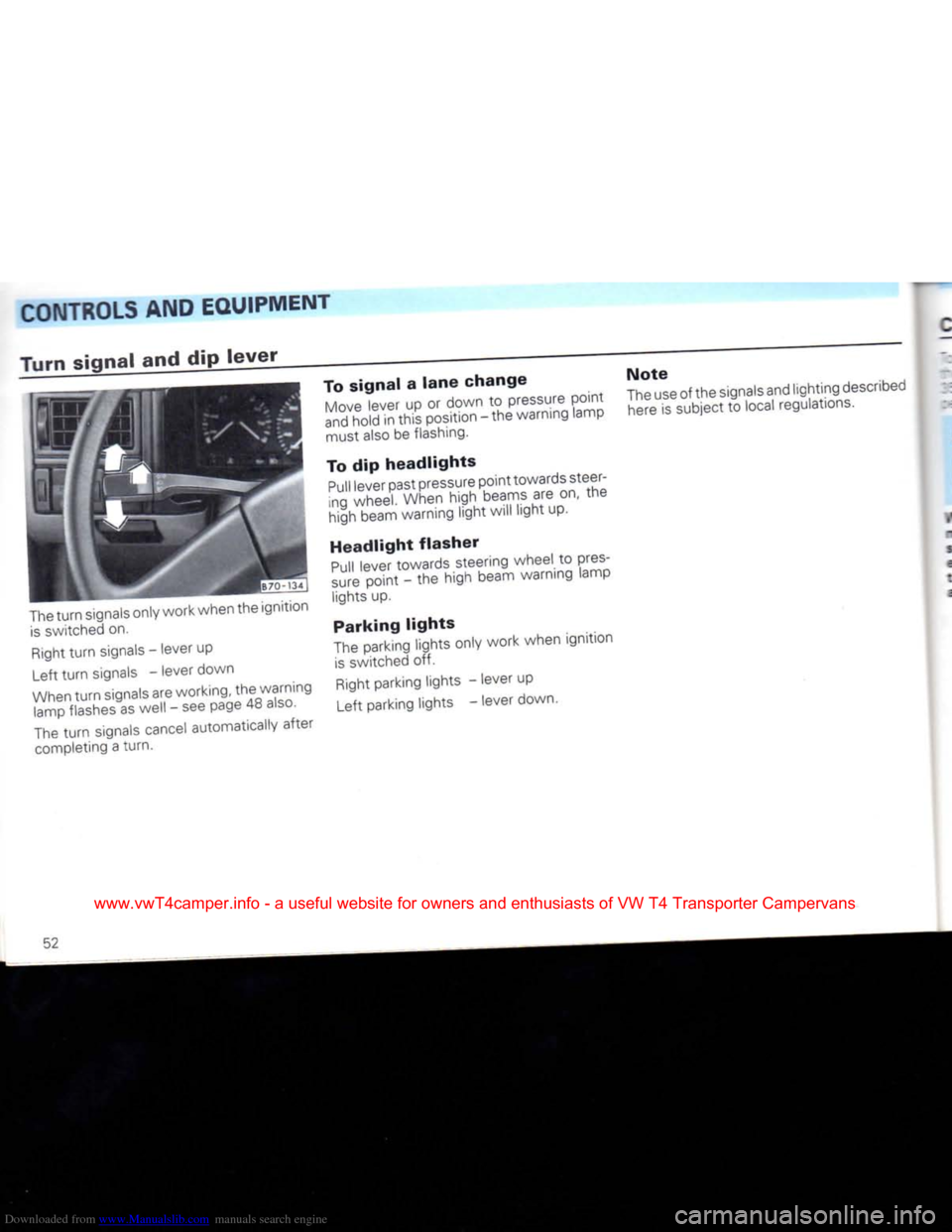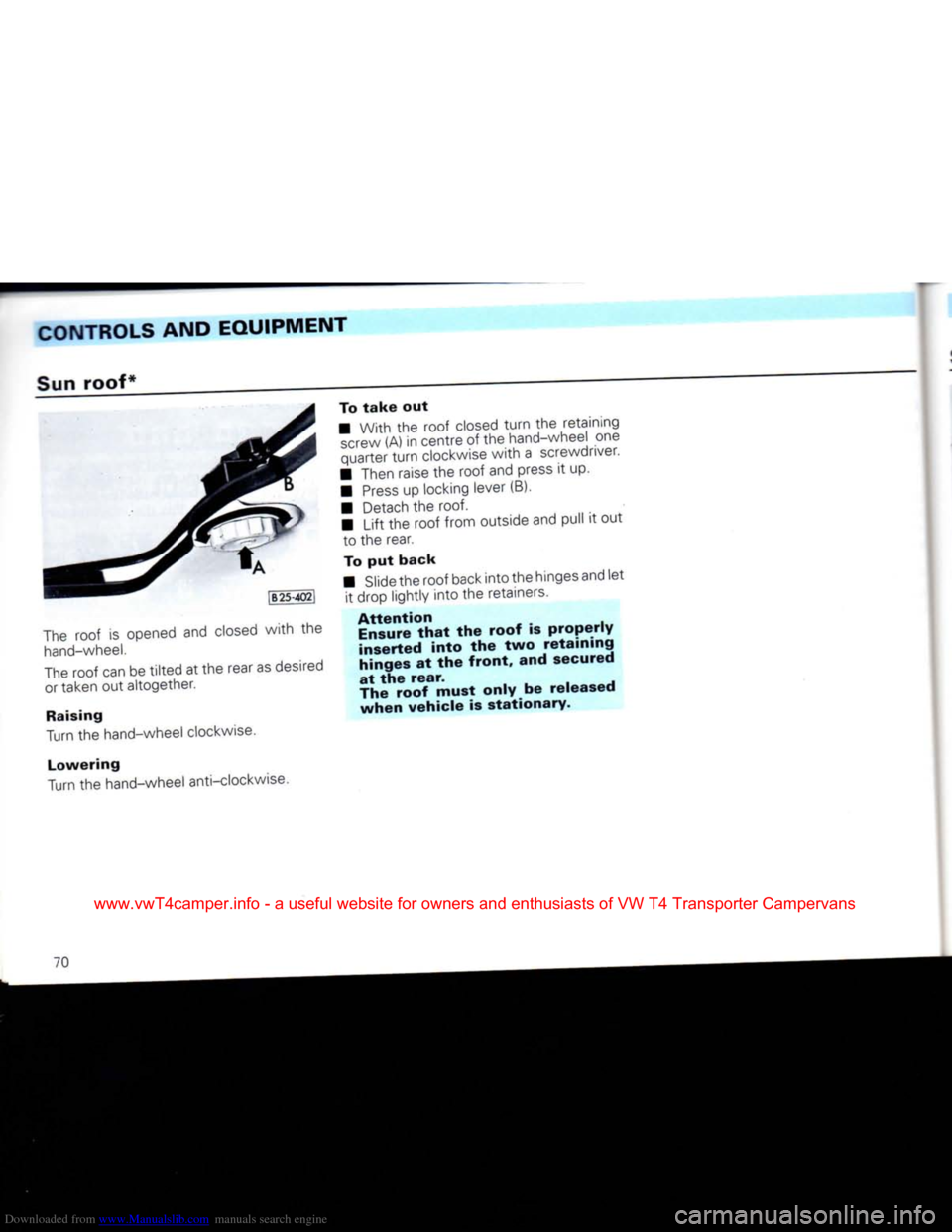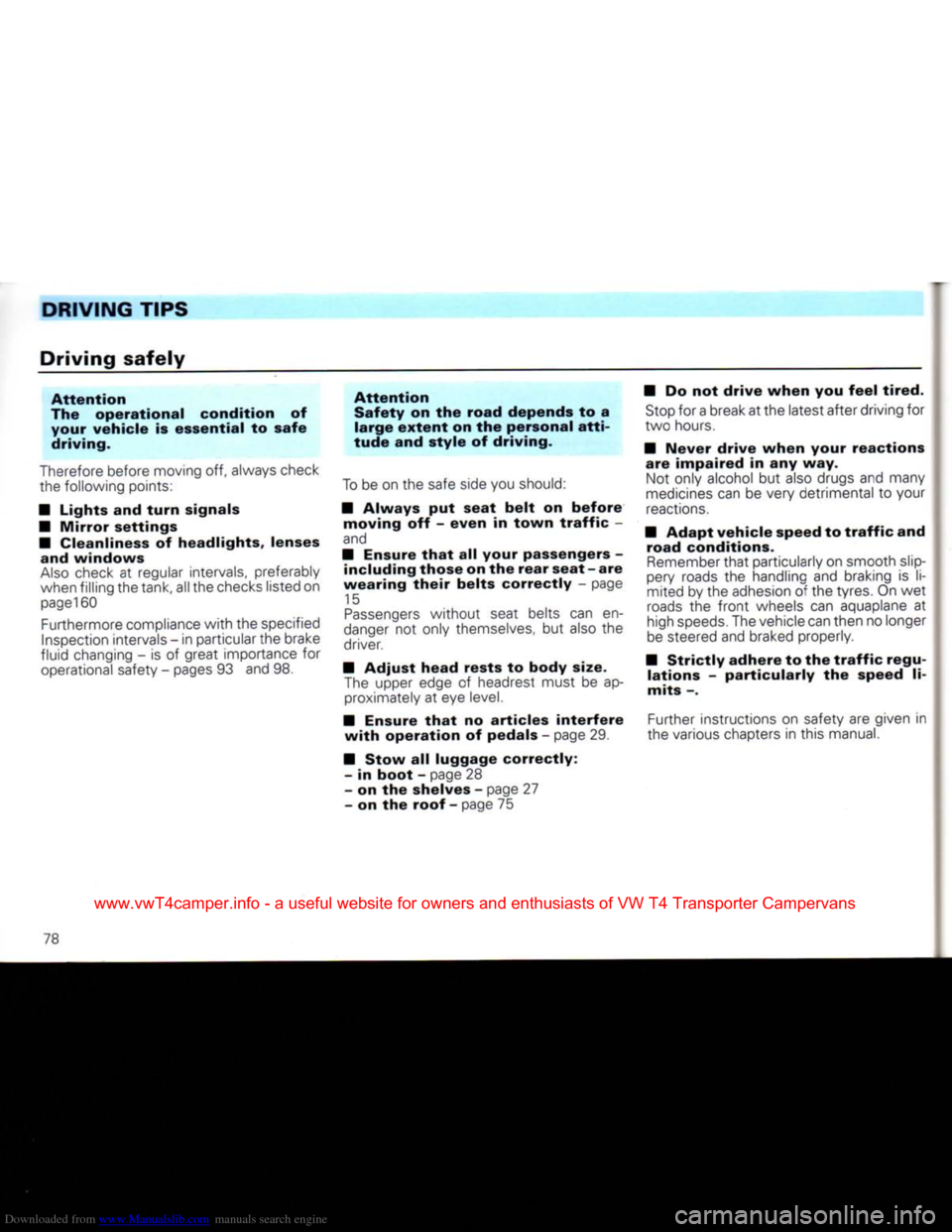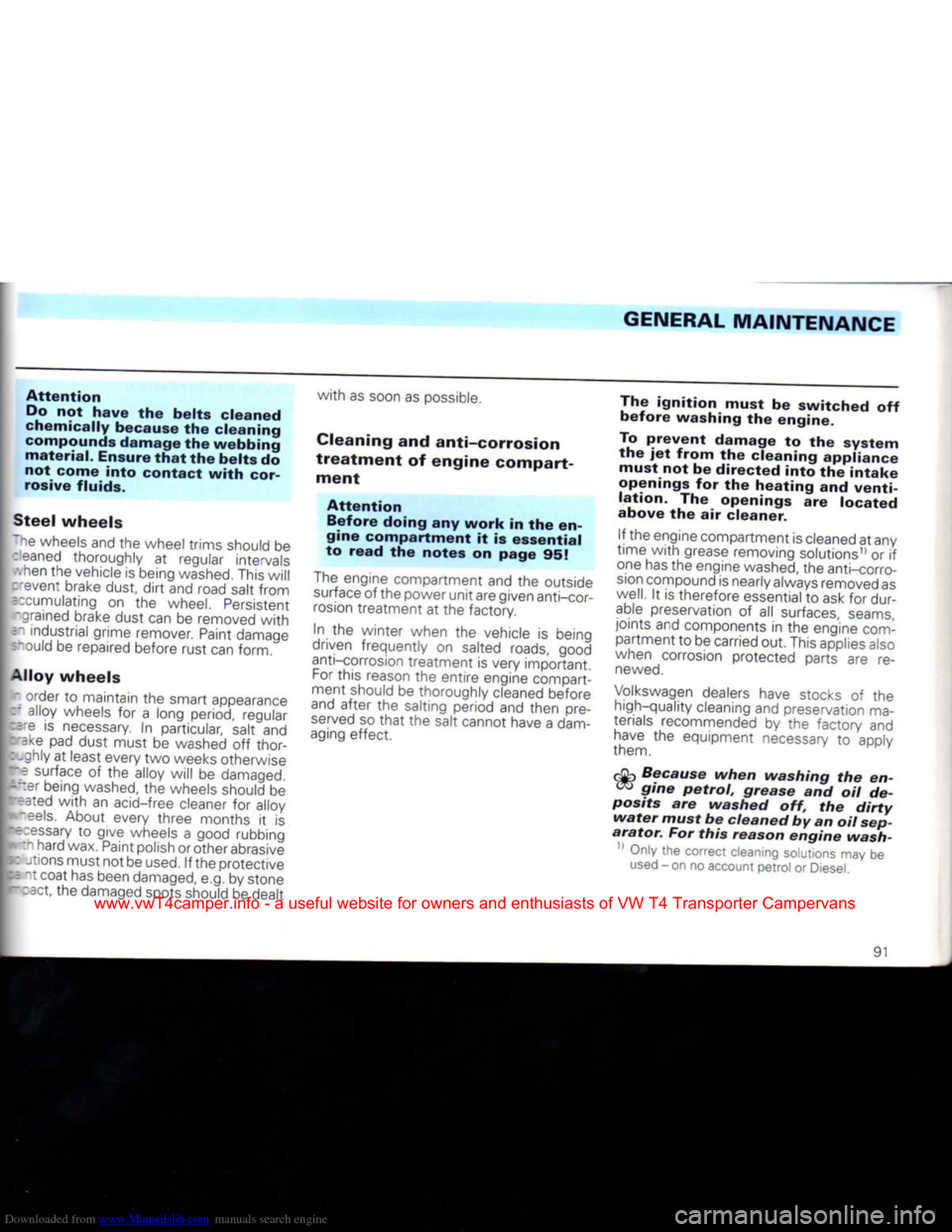1992 VOLKSWAGEN CARAVELLE wheel
[x] Cancel search: wheelPage 53 of 164

Downloaded from www.Manualslib.com manuals search engine
CONTROLS
AND
EQUIPMENT
3
-
Emergency lights .
nen the emergency lights are on, a warn-
'z lamp in the switch flashes as well.
Ine system also works when the ignition is
;
.-.itched off.
4
-
Knurled wheel for seat
^Jf
heating*
~~e cushion and backrest of the
front
seats
:
=
n
be heated electrically when the ignition
s
on.
_~e
heating is switched on and regulated .vth the knurled wheel.
•
switch heating off,
turn
knurled wheel to
:_e
left
to the detent position.
5
-
Heated rear window
QpJ
The
heating works only when ignition is on.
When
heater is on a lamp in the switch lights up.
As soon
as
window
is
clear,
switch element
off. The
reduced
current consumption helps
to re
duce
the
fuel
consumption
- see
also
page
80.
On
vehicles
with
electrically adjustable ex
terior mirrors the mirrors are heated as long
as
the rear window heating is switched on.
6
-
Fog lights •/
|Q
Rear fog light
First
detent - fog lights
Second
-
front
and rear fog
detent lights, or rear fog
light
only
At the second position a warning lamp in the switch comes on.
The fog lights
work
with
the side lights (ignition on), low or high beams.
The rear fog light
works only
with
the fog lights or
with
the low or high beams.
Due
to the amount of
dazzle
it
causes
the
rear
fog
light
should only be switched on
when the visibility is very poor (in Germany
for example, below 50 metres).
Note
The
electrical system of the factory
fitted
tow bar* is wired-up so
that
when towing
a
trailer
fitted
with
rear fog lights, the rear
fog
light
on the towing vehicle are automati
cally
switched off.
51
www.vwT4camper.info - a useful website for owners and enthusiasts of VW T4 Transporter Campervans
Page 54 of 164

Downloaded from www.Manualslib.com manuals search engine
CONTROLS
AND EQUIPMENT
Turn signal and dip
lever
The
turn
signals only work when the ignition
is
switched on.
Right
turn
signals - lever up
Left
turn
signals - lever down
When
turn
signals are working, the warning lamp flashes as well - see page 48
also.
The
turn
signals cancel automatically after
completing a turn. To
signal
a
lane
change
Move
lever up or down to pressure point
and
hold in this position - the warning lamp must also be flashing.
To dip
headlights
Pull
lever past pressure point towards steer
ing wheel. When high beams are on, the
high beam warning light will light up.
Headlight
flasher
Pull
lever towards steering wheel to pres
sure
point - the high beam warning lamp lights up.
Parking
lights
The
parking lights only work when ignition
is
switched off.
Right
parking lights - lever up
Left parking lights - lever down. Note
The
use of the signals and lighting described
here
is subject to local regulations.
52
www.vwT4camper.info - a useful website for owners and enthusiasts of VW T4 Transporter Campervans
Page 56 of 164

Downloaded from www.Manualslib.com manuals search engine
CONTROLS AND EQUIPMENT
Windscreen
wiper
and
washer
system
Wipers
and washers only work when igni
tion is switched on.
The
heated
windscreen
washer
jets*
are switched on when the ignition is switched on and the amount of heat is regulated automatically according to the ambi
ent temperature
When
it is freezing, check
that
the wiper
blades
are not frozen to the glass before
switching the wipers on for the
first
time.
Windscreen
• Flick
wipe
Lift lever to pressure point before detent 1.
•
Wiper
slow
Lever
at position 1. •
Wiper
fast
Lever
at position 2.
•
Intermittent
wipe
Lever
at position 3
The
wipers work about every 6
seconds.
With an
infinitely
variable
intermit
tent
wipe*
the wipe delay can be programmed between about 1.5 and 22
sec
onds:
- Switch on
intermittent
wipe
- Switch off
intermittent
wipe and then switch on again after the desired delay.
The
selected delay can be changed as often
as
required. After switching off the ignition
the selected pause reverts back to a six
sec
ond interval.
•
Automatic
wash/wipe
facility
Pull
lever towards steering wheel - wipers
and
washer work.
Release
lever -
The
washer stops and the wipers carry on
for about 4
seconds.
Headlight washer system*
When
the headlights are on, the lenses are
washed
every time the windscreen is
washed.
At regular intervals such as when filling the
tank, caked-on
dirt
and insects should be
removed.
Rear
window
Press
lever away from steering wheel and
release
- the wiper works about every 6
seconds
(intermittent
wipe).
Pressing
and
releasing
lever again switches the wiper off.
Automatic
wash/wipe
Press
lever away from steering wheel, and
hold in this position -
The
wiper and washer work as long as the
lever
is held in this position.
Release
lever -
The
washer stops and the wiper carries on
for about 4
seconds.
Notes
Topping-up washer fluid
- see page 108.
Changing
windscreen wiper blades
- see page 109
54
www.vwT4camper.info - a useful website for owners and enthusiasts of VW T4 Transporter Campervans
Page 72 of 164

Downloaded from www.Manualslib.com manuals search engine
CONTROLS AND
EQUIPMENT
Sun
roof*
The roof is opened and closed
with
the
hand-wheel.
The roof can be
tilted
at the rear as desired or taken out altogether.
Raising
Turn the hand-wheel clockwise.
Lowering
Turn the hand-wheel anti-clockwise.
To take
out
• With the roof closed
turn
the retaining
screw
(A) in centre of the hand-wheel one
quarter
turn
clockwise
with
a screwdriver.
• Then raise the roof and press it up.
•
Press
up locking lever (B).
• Detach the
roof.
•
Lift
the roof from outside and pull it out to the rear.
To
put
back
• Slide the roof back
into
the hinges and let it drop lightly
into
the retainers.
Attention Ensure that
the
roof
is
properly
inserted into
the two
retaining
hinges
at the
front,
and
secured
at
the
rear.
The roof must only
be
released when vehicle
is
stationary.
70
www.vwT4camper.info - a useful website for owners and enthusiasts of VW T4 Transporter Campervans
Page 80 of 164

Downloaded from www.Manualslib.com manuals search engine
DRIVING
TIPS
Driving
safely
Attention
The
operational
condition of your
vehicle
is
essential
to
safe
driving.
Therefore before moving off, always check
the following points:
• Lights and
turn
signals
•
Mirror
settings
• Cleanliness of
headlights,
lenses and
windows
Also
check at regular intervals, preferably
when filling the tank, all the checks listed on
page160
Furthermore compliance
with
the specified Inspection intervals - in particular the brake
fluid changing - is of great importance for operational safety - pages 93 and 98.
Attention
Safety
on the
road
depends to a
large
extent
on the personal
atti
tude
and
style
of driving.
To
be on the safe side you should:
•
Always
put
seat
belt
on
before
moving
off -
even
in
town
traffic
-
and
• Ensure
that
all your passengers - including
those
on the
rear
seat
- are
wearing
their
belts
correctly
- page
15
Passengers
without seat belts can en
danger
not only themselves, but also the
driver.
•
Adjust
head
rests
to body size.
The
upper edge of headrest must be approximately at eye
level.
• Ensure
that
no
articles
interfere
with
operation
of pedals - page 29
•
Stow
all
luggage
correctly:
- in
boot
- page 28
- on the shelves - page 27
- on the
roof
- page 75 • Do not
drive
when
you
feel
tired.
Stop
for a break at the latest after driving for
two hours.
•
Never
drive
when
your
reactions
are
impaired
in any way. Not only alcohol but also drugs and many
medicines
can be very detrimental to your
reactions.
•
Adapt
vehicle
speed to
traffic
and
road
conditions.
Remember
that
particularly on smooth slip
pery roads the handling and braking is li
mited by the adhesion of the tyres. On wet
roads
the
front
wheels can aquaplane at
high
speeds.
The vehicle can then no longer
be
steered and braked properly.
•
Strictly
adhere
to the
traffic
regu
lations
-
particularly
the speed li
mits
-.
Further instructions on safety are given in
the various chapters in this manual.
78
www.vwT4camper.info - a useful website for owners and enthusiasts of VW T4 Transporter Campervans
Page 85 of 164

Downloaded from www.Manualslib.com manuals search engine
DRIVING
TIPS
• Where possible make
full
use of the maximum permissible drawbar weight on
call
of the towing bracket - see page 151 -
cut do not exceed it.
• While observing the permissible trailer
and
drawbar weight, distribute the load in
the trailer so
that
heavy objects are as near
as
possible to the axle. The objects must
a
so be secured so
that
they cannot slip
aoout.
• Check the
tyre
pressures on the towing
/ehicle
and the trailer.
• The headlight settings, should be
:hecked
with
trailer attached before mov- ng off and adjusted as necessary.
On
vehicles
with
headlight beam control it
is
only necessary to
turn
the knurled disc in
:ash
in the appropriate direction.
Driving
instructions
To
obtain the best possible handling of ve
hicle
and trailer, the following should be
noted:
• Try to avoid driving
with
an unladen ve
hicle
and a loaded trailer. If this cannot be
avoided,
only drive slowly to allow for the unfavourable weight distribution.
• As driving stability of vehicle and trailer
decreases
when the speed increases do not
drive at the maximum permissible top
speed
in unfavourable road, weather or
wind conditions - particularly when going downhill. In any
case
the speed must be reduced im
mediately the trailer shows the slightest
sign
of snaking. On no account try to stop
the snaking by accelerating.
• For safety reasons one should not drive faster than 80 km/h (50 mph). This also
applies
in countries where higher speeds
are permitted. • Always brake in good time. If the trailer
has
an overrun brake, apply the brakes gen
tly at
first
then firmly. This will avoid the
jerk
ing caused by the trailer wheels locking.
Change
down before going down a steep hill so
that
the engine can act as a brake.
• When a long climb in a low gear
with
ex tremely high engine revs must be nego
tiated at exceptionally high ambient temperatures the coolant temperature gauge must be observed. When the gauge needle
moves
to the
>~zza'
e~z of :ne
scale,
the road speed must be reduced immediately. If nevertheless ~g amp flashes,
stop immediately and si ow the engine to
cool
off at idling speed for several minutes.
• The cooling effect of the radiator fan
can
not be increased by changing down, be
cause
the speec of t~e
~a~
s ~o! dependent
on the engine
speed.
One should therefore not change down even when towing a
trailer as long as :-e e-g -e zar cope with out the vehicle speed dropping too much.
83
www.vwT4camper.info - a useful website for owners and enthusiasts of VW T4 Transporter Campervans
Page 93 of 164

Downloaded from www.Manualslib.com manuals search engine
GENERAL
MAINTENANCE
Attention
Do
not have the belts cleaned
chemically
because the cleaning
compounds
damage the webbing
material. Ensure
that
the belts do not come into contact
with
cor
rosive
fluids.
Steel wheels
~ne wheels and
the
wheel trims should
be
:!eaned
thoroughly
at
regular intervals .'.hen the vehicle
is
being washed. This
will
"event brake dust,
dirt
and road salt
from
•cumulating
on the
wheel. Persistent "grained brake dust can
be
removed
with
="
industrial grime remover. Paint damage ;~ould
be
repaired before rust can form.
Alloy wheels - order
to
maintain
the
smart appearance
• alloy wheels
for a
long period, regular pre
is
necessary.
In
particular, salt
and
•Bke
pad dust must
be
washed
off
thor-
cghly
at
least every two weeks otherwise re surface
of the
alloy
will
be
damaged.
-~er
being washed,
the
wheels should
be
~f3ted
with
an
acid-free cleaner
for
alloy
"eels.
About every three months
it is
"f:essary
to
give wheels
a
good rubbing
». :n hard wax. Paint polish or other abrasive
•c
„tions must not be
used.
If
the protective
BE
-.t
coat has been damaged, e.g. by stone react,
the
damaged spots should be dealt
with
as soon
as
possible.
Cleaning and anti-corrosion
treatment
of
engine compart ment
Attention Before doing any
work
in the en
gine compartment it is essential
to read the notes on page 95!
The
engine compartment and
the
outside
surface
of
the power
unit
are given anti-cor
rosion treatment
at the
factory.
In
the
winter when
the
vehicle
is
being
driven frequently
on
salted roads, good
anti-corrosion treatment
is
very important.
For
this reason
the
entire engine compart
ment should
be
thoroughly cleaned before
and after
the
salting period
and
then pre
served
so
that
the
salt cannot have
a
dam
aging effect. The
ignition must be switched off
before washing the engine.
To
prevent damage to the system
the jet from the cleaning appliance must not be directed into the
intake
openings
for the heating and ventilation. The openings are located
above the air cleaner.
If
the engine compartment is cleaned
at
any
time
with
grease removing solutions1'
or if
one has the engine washed, the anti-corro
sion
compound is nearly always removed as
well.
It is
therefore essential
to
ask
for
dur
able
preservation
of all
surfaces,
seams,
joints
and components
in the
engine com partment
to
be carried out. This applies also
when corrosion protected parts
are re
newed.
Volkswagen
dealers have stocks
of the
high-quality cleaning and preservation ma
terials recommended
by the
factory
and
have
the
equipment necessary
to
apply
them.
Because
when
washing
the en
gine
petrol,
grease
and oil de
posits
are
washed
off, the
dirty
water
must
be
cleaned
by an oil
sep
arator.
For
this
reason
engine
wash-
11
Only
the
correct
cleaning
solutions may
be
used
-
on no account petrol
or
Diesel.
91
www.vwT4camper.info - a useful website for owners and enthusiasts of VW T4 Transporter Campervans
Page 101 of 164

Downloaded from www.Manualslib.com manuals search engine
GENERAL
MAINTENANCE
Gearbox
oil
Specifications
Manual
gearbox
and
final
drive
•
Gear
oil,
API-GL
4, SAE 80 or
•
Gear
oil, G 50, SAE 75 W-90
Automatic
gearbox
• Final drive:
Gear
oil, G 50, SAE 75 W-90 I Gearbox part: ATF Dexron®
Checking oil
level
rVith
a
manual
gearbox
and
final
drive
the oil level does not need checking.
'.ith the
automatic
gearbox
the oil
•e.
el in the final drive does not need check- *g either.
"he
ATF
level
in
gearbox
part
must ": .'/ever be checked in between the inter-
•BS
given in Service Schedule. To do this
ire vehicle must be standing on a level sur-
fe:e.
The
level must only be checked when
He ATF is
warm.
(Approximately 10 km
Irrer
starting from
cold,
the ATF has re
tted the required temperature.) If fluid is
l:: :: or too hot the reading will be incorrect.
1
he engine must be running at idling
speed,
the handbrake must be applied and the se lector lever at "N".
To
check, pull dipstick (see Fig.) out, wipe
with a clean lint-free rag and then insert it
fully
again.
Pull
the dipstick out and check ATF
level.
When
the ATF is
warm
the
level
must
be
between
the two
marks
- other
wise
the vehicle must be taken to a
Volks
wagen
dealer without delay so that they can
find the reason for the incorrect
level.
It is not sufficient to merely top up or drain off
ATF.
Changing oil
For
the manual
gearbox
with
final
drive
the oil does not need changing.
For the
automatic
gearbox
the :
the final drive does not need
chariC-g
either. The ATF in gearbox part must how
ever
be changed at the intervals given in
Service
Schedule.
Because of the disposal
prob
lems,
the
special
tools
necessary
and the
specialist
knowledge
re
quired,
the ATF
changing
should
preferably
be
done
by a
Volkswagen
dealer.
Notes
•
When
there
is no
lubricant
in the
manual
or
automatic
gearbox,
the
engine
must
not be
started
and the
vehicle may only be
towed
with
the
driving
wheels
lifted.
• No
additives
may be
mixed
with
the lubricants.
www.vwT4camper.info - a useful website for owners and enthusiasts of VW T4 Transporter Campervans